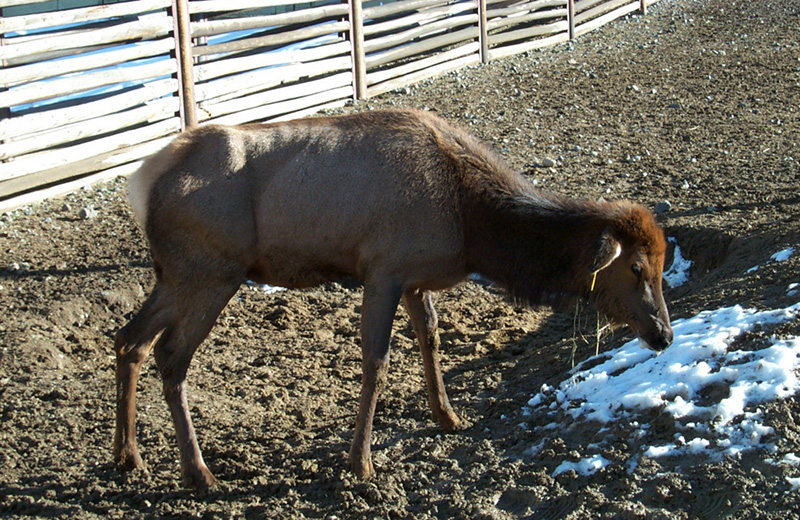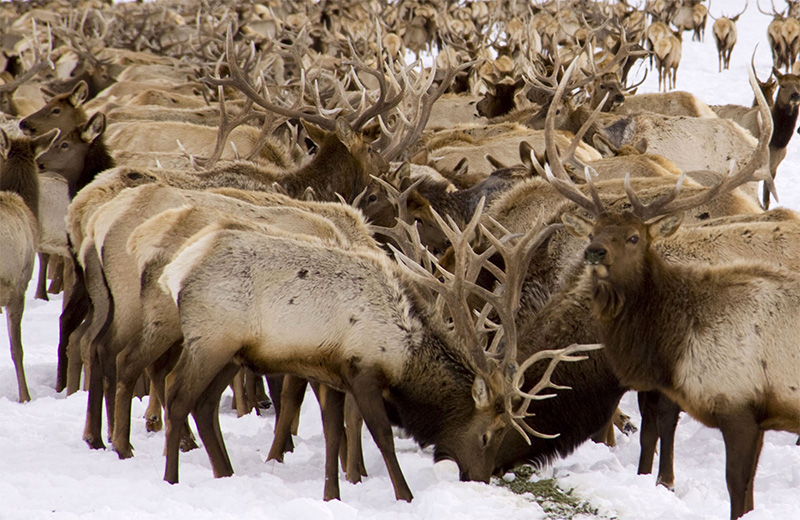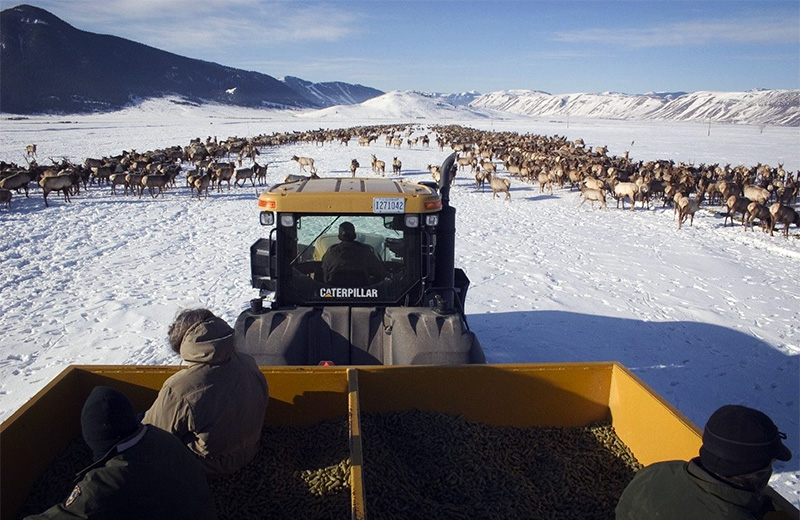A conservation coalition filed a lawsuit against the United States Fish and Wildlife Service (USFWS) on March 18th, asking a judge to order the agency to issue a long-overdue plan to phase out elk feeding on the Jackson Hole National Elk Refuge. The outdated and unnecessary practice of supplemental feeding threatens to accelerate the spread of wildlife diseases — including lethal chronic wasting disease, which was detected for the first time in November in Grand Teton National Park adjacent to the refuge.
The lawsuit comes after the coalition sent a letter in December urging the USFWS to promptly issue a feeding phase-out plan, which the agency committed to release in 2008, but has delayed for more than ten years due to disagreement between federal and Wyoming officials. Since December, the Centers for Disease Control and Prevention has announced that chronic wasting disease has spread to 24 states. Chronic wasting disease is now found in every county in Wyoming, and last year the first cases were documented in Montana.

An elk infected with chronic wasting disease. Always fatal, chronic wasting disease assaults the central nervous systems of elk, deer, and moose, resulting in brain lesions, behavioral changes, a loss of body condition, and ultimately death. Image credit Terry Kreeger / Wyoming Fish and Game Department.
“The National Elk Refuge is supposed to sustain healthy populations of native wildlife, not spread infection of lethal disease,” said Earthjustice attorney Tim Preso. “Yet the crowded conditions on winter-time elk feeding lines threaten to allow lethal disease to spread among the Refuge elk like a cold in a kindergarten classroom.”
Earthjustice filed the lawsuit on behalf of Defenders of Wildlife, the Sierra Club, and the National Wildlife Refuge Association.
“The National Elk Refuge is a national treasure and we cannot afford further delay in addressing the grave risks posed by chronic wasting disease to the Refuge and its wildlife,” said Peter Nelson, director of federal lands for Defenders of Wildlife. “We urge the Service to act immediately to begin phasing out its supplemental winter-feeding program and reducing dangerous elk densities before it is too late.”
At the same time a management plan is being delayed, chronic wasting disease — the elk version of “mad cow disease” — has crept ever closer to the Refuge. A slow, debilitating, and inevitably fatal illness, chronic wasting disease assaults the central nervous systems of elk, deer, and moose, resulting in brain lesions, behavioral changes, a loss of body condition, and always death.

Elk crowd together along artificial feedlines in the National Elk Refuge. Image credit U.S. Fish and Wildlife Service.
“It has been over a decade since the Refuge committed to a plan to phase out the feeding of elk, which has resulted in an ecosystem that is out of balance — where animals are unnaturally and dangerously concentrated together. It’s past time to end this outdated and high-risk practice,” said Lloyd Dorsey, Sierra Club Wyoming Chapter program manager. “The economy of the Greater Yellowstone Ecosystem is based on abundant wildlife, and the best way to ensure healthy wildlife, healthy habitat, and a healthy economy in the long term is to end artificial feeding, allow elk to roam free and for wildlife to remain wild.”
Scientists predict that chronic wasting disease will spread rapidly among elk crowded along feedlines, and widespread infection will also contaminate Refuge soils and vegetation where disease materials would persist to infect more animals for years. The threat reached a new level of urgency in November with the discovery of a mule deer infected with the always-lethal disease in Grand Teton National Park, which is adjacent to the Refuge.
“Chronic wasting disease is a greater threat now than ever before to wildlife at the National Elk Refuge,” said Geoffrey Haskett, president of the National Wildlife Refuge Association. “We can no longer wait to phase out supplemental feeding.”

Elk in the National Elk Refuge crowd together for artificial feeding by tractor feeder. Image credit U.S. Fish and Wildlife Service.
Time for new methods at national elk refuge
Most recent winters have seen more than 8,000 elk crowded on Refuge feedlines, where they consume alfalfa pellets that FWS provides. In 2007, FWS issued a plan promising that within a year the agency would provide a blueprint for phasing out the winter-feeding program. Reviewing that plan, the U.S. Court of Appeals for the District of Columbia Circuit ruled in 2011 that “[t]here is no doubt that unmitigated continuation of supplemental feeding would undermine the conservation purpose of the National Wildlife Refuge System.” Yet to this day, FWS has still not released the feeding phase-out plan that was promised for release in 2008.
Meanwhile, chronic wasting disease has now been detected in close proximity to the National Elk Refuge in Grand Teton National Park, where Wyoming officials announced on November 21, 2018 that a mule deer struck by a car was infected with the disease. This detection marked the first time that this disease has been detected in Jackson Hole itself.
Winter-time feeding of elk on the National Elk Refuge began in 1912 as a means of sustaining elk through the winter season and resolving conflicts with ranchers feeding livestock. More than a century later, the concentration of elk on Refuge feed lines has led to the degradation of habitat and prevents the restoration of historic elk migration patterns in the Greater Yellowstone Ecosystem. More significantly, the unnaturally high concentrations of elk have led to a high prevalence of other diseases including brucellosis and scabies, and a significantly increased threat of an outbreak of lethal chronic wasting disease.
Featured image: wintering elk on the National Elk Refuge. Image credit USFWS Mountain-Prairie, CC BY-SA 3.0.





